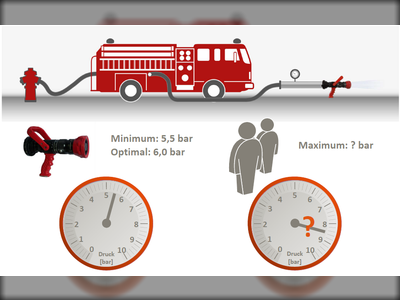Internationally, no uniform regulation exists about the pressure limits of water used for putting out fires in high-rise buildings and extended real estates. It is difficult to establish the ideal water pressure, since on the one hand, the branchpipe needs a defined pressure in order to work efficiently and on the other hand, this pressure may not be too high for a secure handling of the branchpipe. Our tests should answer the question of how high the water pressure to be adjusted to ensure a physiologically executable and safe indoor fire-fighting.
The difficulty lies in the fact that for many branchpipes a certain minimum working pressure is set, but this must be limited to the top, to ensure safe operation of the jet by the fire-fighters. The aim was to determine the physiological strain responses at different water pressures and flows in order to derive the maximum allowable pressure for a given amount of water for fire-fighting.

Solution: Installation of fire-fighting water systems via permanently instulled pumps according to statutory orders and technical standards.

12 professional male fire-fighters carried out simulated fire-fighting procedures under realistic conditions. All participants were of normal build and right-handed.
Throughout the entire test, the electromyographic activity (EA) from 7 muscles of the right hand-arm-shoulder system and one muscle of the left arm was recorded. Additionally, a special questionnaire had to be filled in to evaluate the subjective responses when handling the branchpipes with the varying pressure and flow rates. Static strain was expected for the muscles of the right side when the branchpipe was held in the right hand. The left hand carried out dynamic work as it opened, closed and operated the branchpipe.
They used two different hand-held branchpipes, the classical multi-purpose branchpipe (flow rate 200 l/min) which is hardly used any more today and a combination branchpipe (flow rate 235 l/min and 400 l/min). The fire-fighters were asked to hold a solid stream in a standing position for 30 seconds and afterwards dispense sprays pulses in a standing and kneeling position, each in different positions of their body and hand-arm-shoulder system according to a given test-procedure. After each run at a defined flow rate (200, 235 or 400 l/min), the pressure was changed in 0.2 MPa steps between 0.4 and 1.0 MPa.
The EA has been standardized by means of isometric MVCs (Maximum Voluntary Contractions). As expected, the standardized EA increased with rising pressure and flow rate. The myoelectric activity of the right flexor digitorum and the clavicular part of the deltoid exceeded the limit for short-term static work dependent on the nature of the activity (20% of the MVCs when holding a solid stream and 50% when dispensing spray pulses) only when the pressure and flow rate were very high (1.0 MPa, 400 l/min).
The biceps brachii, flexor carpi ulnaris and extensor digitorum of the right hand-arm-shoulder system represented the work-physiological bottleneck. For these muscles 0.8 MPa and 235 l/min were just acceptable whereas 0.8 MPa and 400 l/min as well as 1.0 MPa with both flow rates exceeded the specified limits above.
While using the multi-purpose branchpipe, only the extensor digitorum was associated with extreme physiological responses at a pressure of 0.8 MPa and higher with a flow rate of 200 l/min.
The subjective ratings confirmed the measured physiological responses. The fire-fighters perception in the general performance of the simulated fire-fighting declined with rising pressure and flow rate. Furthermore the subjectively assessed overall body strain rose significantly with a pressure of 0.8 MPa and higher, with a personally perceived safety decline.
Based on these results, the maximum pressure for the fire water supply should be limited to 0.6 MPa/6 bar, in order to ensure the branchpipes most efficient working and safe as well as precise fire extinguishing.